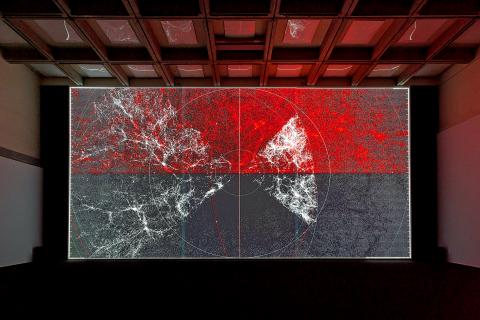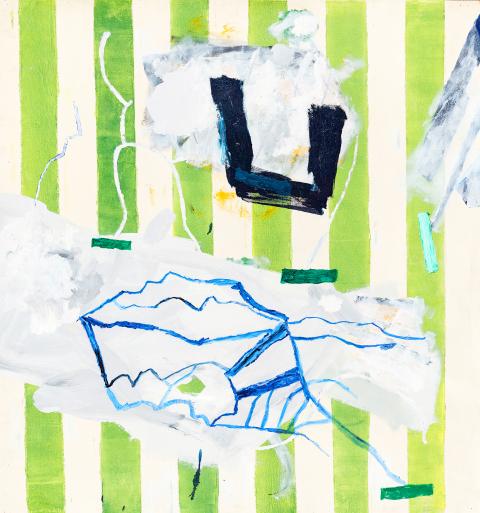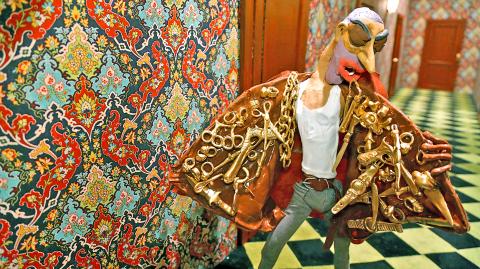Double Square Gallery presents Fuse (影.暴.性), a video art exhibition that features diverse perspectives of the body. “Fuse” suggests a potential for ignition, a beginning point for discussions around issues concerning gender awareness, identity and power, popular culture and social violence. The show includes three artists and an artist group from Sweden, UK and Taiwan who share an interest in provocative use of image and sound. Nathalie Djurberg and Hans Berg are an artist duo who live and work in Berlin. They combine animation, sculpture and sound to create imaginative videos and installations about the desires of humans and animals. One Need Not be a House The Brain Has Corridors is a single channel digital film about the mistranslation between impulses and impressions. With a dose of dark comedy, the film rolls out some serious criticism about social doctrines, class hierarchies and the dominance of the human race.
■ Double Square Gallery (雙方藝廊), 28, Lane 770, Beian Road, Taipei City (台北市北安路770巷28號), tel: (02) 8501-2138. Open Tuesdays to Sundays from 10:30am to 6:30pm
■ Until Sept. 21

Photo Courtesy of Taipei Fine Arts Museum
Ryoji Ikeda is a prominent Japanese visual and sound artist known for his live performances, installations, publications and recordings that explore concepts in music, mathematics, quantum mechanics, physics, philosophy and audiology. Ikeda, a self-taught artist, was exposed to a range of music at an early age. He experimented with ways to edit music, such as manipulating magnetic tape and sound frequencies, in search of fundamental questions about sound. While he spent several years in the 1990s committed to cross-disciplinary collaborations in theater and art, in 1995, Ikeda started focusing on creating minimalist electronic music that searched for the definition of sound. His latest solo exhibition, Ryoji Ikeda Solo Exhibition, is currently being shown at Taipei Fine Arts Museum (台北市立美術館). The show includes a selection of iconic works from the artist’s career that demonstrate the potential of data and code language to respond to metaphysics and spirituality.
■ Taipei Fine Arts Museum (台北市立美術館 TFAM), 181, Zhongshan N Rd Sec 3, Taipei (台北市中山北路三段181號), tel: (02) 2595-7656. Open Tuesdays to Sundays from 9:30am to 5:30pm and until 8:30pm on Saturdays
■ Until Nov. 17

Photo Courtesy of Taipei Fine Arts Museum
National Palace Museum (國立故宮博物院) opens a new show that sheds light on the museum’s document archives. Treasures from the National Palace Museum’s Collection of Qing Dynasty Historical Documents (院藏清代歷史文書珍品) features a selection of imperial decrees, official papers, memorandums, biographies, maps and illustrations that were once strictly confidential and closely guarded by the Qing imperial palace. These artifacts offer a glimpse into governmental operations, details of court life and other well-kept secrets about the emperor and his officials. The show includes a section that relates to the Qing’s rule over Taiwan. Official documents, maps and gazetteers show the court’s interest in the people, places, affairs and resources of Taiwan. Illustrations and Discourses on the Restoration of Official Buildings in the Prefecture of Taiwan is a colorful album depicting plans to repair architecture around the city proposed by Jiang Yuan-shu (蔣元樞), prefect of Taiwan during the 18th century.
■ ■ ■ National Palace Museum (國立故宮博物院), 221 Zhishan Rd Sec 2, Taipei City (台北市至善路二段221號), tel: (02) 2881-2021. Open daily from 8:30am to 6:30pm; closes at 9pm on Fridays and Saturdays
■ Until Feb. 16

Photo Courtesy of Kuandu Museum of Fine Arts
Lin Yi-hsuan (林亦軒) has lived in New York and South America, and incorporates his experience of these places into abstract paintings, translating people and places into rough and delicate compositions. Lin’s solo exhibition, We Are Turtles (我們是烏龜), at Kuandu Museum of Fine Arts (關渡美術館), presents a selection of new paintings from 2014 to this year. When speaking about his work, Lin uses the pronoun we, referring to himself and his companion turtle who is a metaphor for time. Inspired by American beat generation writer Jack Kerouac, Lin seeks to go beyond the surface of painting and to discover its meaning with a wandering, stumbling and nomadic attitude. Using methods akin to graffiti and collage, the artist mediates his daily encounters into symbolic gestures.
■ Kuandu Museum of Fine Arts (關渡美術館), 1 Xueyuan Rd, Taipei City (台北市學園路1號), tel: (02) 2896-1000 X 2432. Open Tuesdays to Sundays from 10am to 5pm
■ Until Sept. 22

Photo Courtesy of Double Square Gallery
Huang Chia-ning (黃嘉寧) paints from small referential photographs. She depicts them faithfully, yet the size of the images provides limited detail. It is in this lack of clarity that the artist seeks to find expression. Huang’s choice of subject does not take a definite theme; she draws from different fragments of personal life and memories. Her solo exhibition, The Realistic Painting of Huang Chia-ning (如實知見), is currently on view at the Kaohsiung Museum of Fine Arts (高雄市立美術館). In the show’s preface, Huang seeks to orient herself in the Information Age. “[I wonder] if the explosion of knowledge and information nowadays has made it more difficult for people to focus or acquire the right food for thought … [H]ow can an artist like me find the right food for thought and use it in the right way and in the right place,” she writes.
■ Kaohsiung Museum of Fine Arts (高雄市立美術館), 80, Meishuguan Rd, Kaohsiung City (高雄市美術館路80號) tel: (07) 555-0331. Open Tuesdays to Sundays from 9:30am to 5:30pm
■ Until Oct. 13

In the March 9 edition of the Taipei Times a piece by Ninon Godefroy ran with the headine “The quiet, gentle rhythm of Taiwan.” It started with the line “Taiwan is a small, humble place. There is no Eiffel Tower, no pyramids — no singular attraction that draws the world’s attention.” I laughed out loud at that. This was out of no disrespect for the author or the piece, which made some interesting analogies and good points about how both Din Tai Fung’s and Taiwan Semiconductor Manufacturing Co’s (TSMC, 台積電) meticulous attention to detail and quality are not quite up to

April 21 to April 27 Hsieh Er’s (謝娥) political fortunes were rising fast after she got out of jail and joined the Chinese Nationalist Party (KMT) in December 1945. Not only did she hold key positions in various committees, she was elected the only woman on the Taipei City Council and headed to Nanjing in 1946 as the sole Taiwanese female representative to the National Constituent Assembly. With the support of first lady Soong May-ling (宋美齡), she started the Taipei Women’s Association and Taiwan Provincial Women’s Association, where she

Chinese Nationalist Party (KMT) Chairman Eric Chu (朱立倫) hatched a bold plan to charge forward and seize the initiative when he held a protest in front of the Taipei City Prosecutors’ Office. Though risky, because illegal, its success would help tackle at least six problems facing both himself and the KMT. What he did not see coming was Taipei Mayor Chiang Wan-an (將萬安) tripping him up out of the gate. In spite of Chu being the most consequential and successful KMT chairman since the early 2010s — arguably saving the party from financial ruin and restoring its electoral viability —

It is one of the more remarkable facts of Taiwan history that it was never occupied or claimed by any of the numerous kingdoms of southern China — Han or otherwise — that lay just across the water from it. None of their brilliant ministers ever discovered that Taiwan was a “core interest” of the state whose annexation was “inevitable.” As Paul Kua notes in an excellent monograph laying out how the Portuguese gave Taiwan the name “Formosa,” the first Europeans to express an interest in occupying Taiwan were the Spanish. Tonio Andrade in his seminal work, How Taiwan Became Chinese,